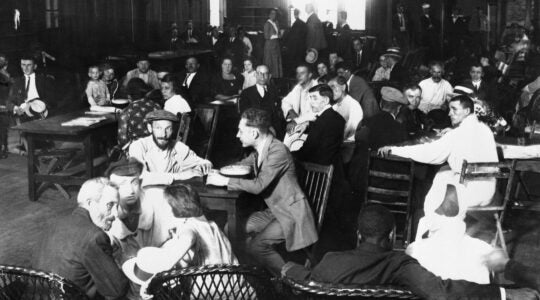NEW YORK (JTA) – Children dressed in costumes. Parents celebrating. Stories of massacres greeted with revelry.
Sounds like a decent pitch for Hamas television – if you switch out the Hebrew for Arabic and ignore that it’s the scene at most synagogues in the world on the night of Purim.
To be fair, most of the Jews in the pews – and for that matter, the rabbis in the pulpits – don’t think of it that way.
The tendency is to view Megillat Esther as the prototypical story of survival in the Diaspora, with the general focus on Mordechai’s political astuteness and the role of unseen divine intervention.
Yes, the deaths of Haman and his sons are cheered. But little if any attention is paid to the most gruesome passages of the story, when Mordechai and Esther pave the way for the Jews to carry out bloody massacres against their foes.
“The Jews,” we learn at the start of the Megillah’s next-to-last chapter, “smote all their enemies with the stroke of the sword and with slaying and destruction, and they did to their enemies as they wished.”
And that was just the first day.
Seeing that Mordechai and the Jews are not to be messed with, King Ahasuerus hands Esther the keys to the castle and asks her what she wants. Her answer: more blood.
The death toll in the end was about 800 men in Shushan and 75,000 in the rest of the empire.
Of course by that point, most people in shul, especially outside the Orthodox world, are thinking ahead to the carnival. Ask them about violence in the story and most won’t get past the killing of Haman and his sons. It’s as if the concluding tidal waves of blood are a minor footnote, hardly the central point and not vital to understanding the message of the Megillah.
This sanitized view explains to some degree the level of shock and outrage that most Jews around the world felt in response to news in 1994 that a West Bank settler, Baruch Goldstein, had gunned down about 30 Muslim worshipers at a religious site in Hebron – on Purim.
While Goldstein’s moral compass was demonically broken, his sense of timing was not: No matter how much the modern Jew focuses on the food, drink and fun, skips over the latter portions of the story, and chooses to see Mordechai strictly as a master political maneuverer, Megillat Esther has something quite dark to say about confronting truly evil enemies.
With Israel facing continued rocket attacks and reeling from the most heinous of terror attacks – not to mention coping with a modern-day Haman in Persia eyeing nuclear weapons – it’s a good year to ponder that message.
To be clear, for nearly two millennia many revered rabbis have stressed that the biblical injunction to wipe out all of Amalek – issued in the Torah after Haman’s ancestors attacked the women, children and elderly among the Israelites following the exodus from Egypt – does not apply to any existing race or nationality. So, for example, Goldstein’s random targeting of innocent Palestinians was almost universally, and rightly, condemned by Jews.
But this praiseworthy rabbinic reflex to mute incitement to mass murder does not negate the less jarring yet equally powerful warning that the Purim story offers regarding negotiations with a sworn enemy: Some foes are so foul and immoral that accommodation is ultimately the riskiest course, even if the alternative carries obvious dangers.
This message is hammered home by Mordechai’s refusal at the beginning of the story to bow down to Haman. How else to explain such a seemingly reckless provocation on the part of the story’s most politically adept character than to accept that Mordechai saw something fundamental in Haman’s nature that made compromise and acceptance even more perilous than confrontation?
Refocusing our attention to different sections of the Megillah must never be transformed into an excuse for murder. Nor will this approach provide a clear answer as to whether any of Israel’s current diplomatic or military adversaries – Fatah, Hamas, Hezbollah, Iran’s Islamic fundamentalist leaders – fall into the category of those who cannot be negotiated with, or how to proceed if they do.
But it will offer a healthy reminder that in rare cases, accommodation is the most dangerous course.





